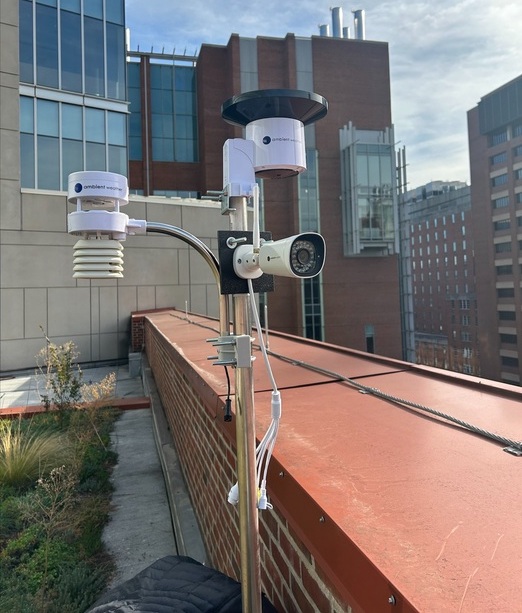Wind of Change: UMB Installs Small Weather Station
March 26, 2024 Elizabeth Main
Read about the station, which will take measurements including temperature, humidity, solar radiation, UV, wind direction, and wind speed, in the latest issue of “CATALYST” magazine.
The extended forecast is calling for a small weather station at the University of Maryland, Baltimore (UMB), bringing the city’s weather data even closer to home.
UMB’s Office of Sustainability worked with Operations and Maintenance to install a small weather station on the sixth-floor green roof of Health Sciences Research Facility III (HSRF III) in November. This weather station will take measurements including temperature, humidity, solar radiation, UV, wind direction, and wind speed, among other data points.
The Office of Sustainability first explored the idea of a campus weather station after creating a Tree Equity story map highlighting the inequities that exist in the distribution of tree canopy in Baltimore. This inequity leads to the urban heat island effect, meaning that areas with fewer trees absorb more heat and thus feel much hotter than their more shaded counterparts.
When looking up weather for a particular city, the data displayed are typically readings from weather stations at the nearest airport. For Baltimore, these readings are taken at Baltimore-Washington International (BWI) Thurgood Marshall Airport, which is nearly 10 miles from UMB’s campus. Installing a campus weather station allows UMB to get more localized data on temperature and can help illustrate the effects of the urban heat island effect at the downtown campus.
Readings taken from the weather station also will aid the work of other departments at UMB, including the Office of Emergency Management (OEM) and Environmental Services (EVS) in responding to extreme weather events. A camera will provide a live feed of the weather on UMB’s campus and an additional vantage point for UMB Police and Public Safety’s monitoring efforts.
“Folks at UMB had looked into a weather station in the past, but I’m glad we were able to turn this dream into a reality,” says Angela Ober, senior specialist in the Office of Sustainability. “These data will not only benefit our office, but also groups on campus such as Emergency Management, Environmental Services, Operations and Maintenance, Public and Occupational Health, Public Safety, and others. It will be interesting to compare the data gathered to other nearby stations, and the hope is to find a second location on campus to compare micro-climates within the University’s campus boundaries.”
Read more about the weather station in the latest issue of CATALYST magazine.
You can read the Fall 2023 issue of CATALYST magazine, which highlights UMB's Center for Violence Prevention and its executive director; the University's three new deans; UMB's many innovations such as the School of Pharmacy training students to administer long-acting injectables; community initiatives such as the Community Engagement Center's workforce programs; and much, much more!